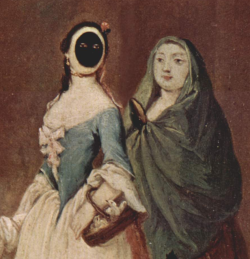In medieval Italy, a visard was a small mask that covered a woman's face.
It had a black velvet exterior and a white silk interior, and sewn inside at the mouth was a small black glass bead. Held on by this bead between the teeth, the woman could not speak when wearing the mask — her speech was hidden as well as her expression.
Masks often impede the wearer's ability to use their voice comfortably. This mystery upon mystery was considered very attractive.
The visard was used by noblewomen to protect their beauty from weathering or to conceal their identities when it suited them.


In those places of the world where women cover their faces in daily life, as well as other things, they are not considered any less admirable by men on the street.
It has been said about the burqa:
"How beautiful to remain a mystery in a world of people who have nothing left
to hide."
To some, the apex of beauty is beauty that is actively negated. It is a paradox illustrated by many practises in human society, across time and geography.
A fantasy is always more dazzling
than the actual.